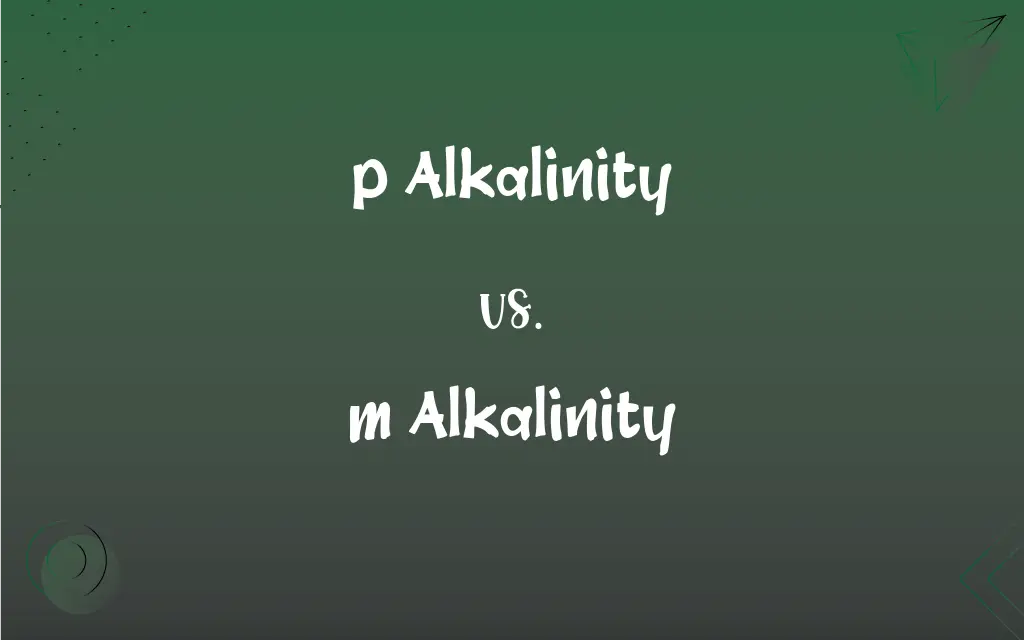p Alkalinity vs. m Alkalinity: What's the Difference?
Edited by Aimie Carlson || By Janet White || Published on February 2, 2024
P alkalinity measures bicarbonate & carbonate ions, indicating water's buffering capacity. M alkalinity, also total alkalinity, assesses carbonates, bicarbonates, and hydroxides.

Key Differences
P alkalinity, or Phenolphthalein alkalinity, specifically quantifies bicarbonate (HCO3-) and carbonate (CO3^2-) ions in a solution. It's determined by titration to a pH of 8.3. M alkalinity, known as Methyl Orange alkalinity or Total alkalinity, encompasses the total concentration of carbonate, bicarbonate, and hydroxide ions. It's measured by titration to a lower pH of 4.5, capturing a broader range of alkaline substances.
P alkalinity serves as an indicator of the water's buffering capacity against acidification, primarily due to bicarbonates and carbonates. It’s crucial in maintaining stable pH in environments like aquariums and pools. M alkalinity, on the other hand, offers a more comprehensive measure of water's ability to neutralize acids, including the presence of hydroxides. This makes it vital in processes like water treatment and environmental monitoring.
In testing water quality, P alkalinity is often measured first. If P alkalinity is present, it suggests the presence of significant carbonate and bicarbonate ions. M alkalinity is measured subsequently to determine the total alkaline content, including hydroxides, which are not detected in P alkalinity testing.
P alkalinity is sensitive to pH changes and can provide insights into the carbon dioxide balance in water systems. Conversely, M alkalinity is less sensitive to such fluctuations, offering a broader perspective on the water’s overall alkaline state.
Analyzing both P alkalinity and M alkalinity is essential for comprehensive water quality assessment. While P alkalinity focuses on specific ions, M alkalinity gives an overall view of the water's capacity to neutralize acids, essential for environmental, industrial, and aquatic health.
ADVERTISEMENT
Comparison Chart
Ions Measured
Bicarbonate and Carbonate
Carbonate, Bicarbonate, Hydroxide
PH for Titration
PH 8.3
PH 4.5
Sensitivity to pH Changes
More Sensitive
Less Sensitive
Application
Aquariums, Pools
Water Treatment, Environmental Monitoring
Indication
Buffering Capacity
Total Alkaline Content
ADVERTISEMENT
p Alkalinity and m Alkalinity Definitions
p Alkalinity
P alkalinity can indicate excess carbon dioxide in water.
The rising P alkalinity suggests increased CO2 levels in the lake.
m Alkalinity
M alkalinity provides a broad view of water’s acid-neutralizing capacity.
Analyzing the M alkalinity helps us understand the water treatment process efficiency.
p Alkalinity
P alkalinity measures water's bicarbonate and carbonate content.
The pool's P alkalinity was adjusted to maintain a stable pH.
m Alkalinity
M alkalinity is quantified by titration to a pH of 4.5.
The titration reached pH 4.5, revealing the water's M alkalinity.
p Alkalinity
P alkalinity helps in understanding water's buffering capacity.
High P alkalinity in the aquarium ensures a stable environment for the fish.
m Alkalinity
M alkalinity includes bicarbonate, carbonate, and hydroxide ions.
The M alkalinity test confirmed the presence of hydroxides in the industrial waste.
p Alkalinity
P alkalinity is crucial for aquatic life in controlled environments.
To protect our marine species, we regularly monitor the P alkalinity.
m Alkalinity
M alkalinity is essential in environmental monitoring and water treatment.
We monitor M alkalinity to ensure the safety of our drinking water.
p Alkalinity
P alkalinity is determined by titrating to a pH of 8.3.
We reached a pH of 8.3, indicating the water's P alkalinity.
m Alkalinity
M alkalinity measures total alkaline substances including hydroxides.
The river’s M alkalinity was tested to assess its health.
FAQs
Can P alkalinity indicate CO2 levels in water?
Yes, it can suggest changes in carbon dioxide concentrations.
How is P alkalinity determined?
It’s determined by titrating to a pH of 8.3.
What does a high P alkalinity mean?
High P alkalinity means a strong ability to buffer against acidification.
Why is P alkalinity important in aquariums?
It indicates the water's buffering capacity to maintain a stable pH for aquatic life.
What does M alkalinity measure?
M alkalinity measures the total concentration of carbonate, bicarbonate, and hydroxide ions.
What does P alkalinity measure?
P alkalinity measures the concentration of bicarbonate and carbonate ions in water.
Are there any risks of high P alkalinity in pools?
High P alkalinity can lead to scaling and cloudy water.
Why is M alkalinity important in water treatment?
It assesses water’s total capacity to neutralize acids, crucial for treatment processes.
What does a high M alkalinity indicate?
High M alkalinity indicates a strong overall alkaline content, including hydroxides.
Does P alkalinity affect water clarity?
Indirectly, as it helps in maintaining a stable pH which can influence clarity.
Is M alkalinity testing more comprehensive than P alkalinity?
Yes, it gives a broader perspective on the water’s alkaline state.
What is the ideal P alkalinity range for freshwater aquariums?
Ideal ranges vary, but generally, it’s around 80-120 ppm.
Is it necessary to adjust M alkalinity in water treatment?
Yes, adjusting M alkalinity is crucial for ensuring the safety and balance of treated water.
How is M alkalinity different from P alkalinity?
M alkalinity includes hydroxides and is measured at a lower pH of 4.5.
Can P alkalinity testing be skipped if M alkalinity is measured?
No, both tests provide different and important information about water quality.
How often should P alkalinity be tested in an aquarium?
It depends on the tank's ecosystem, but generally, regular testing is recommended.
How does temperature affect M alkalinity measurements?
Temperature can influence the solubility and dissociation of alkaline compounds, affecting measurements.
What tools are used for measuring P and M alkalinity?
Titration kits and pH meters are commonly used for these measurements.
What role does M alkalinity play in environmental monitoring?
It helps in assessing the health of natural water bodies and their ability to withstand acidic pollutants.
Can M alkalinity testing detect pollution?
Indirectly, as changes can indicate the presence of acidifying pollutants.
About Author
Written by
Janet WhiteJanet White has been an esteemed writer and blogger for Difference Wiki. Holding a Master's degree in Science and Medical Journalism from the prestigious Boston University, she has consistently demonstrated her expertise and passion for her field. When she's not immersed in her work, Janet relishes her time exercising, delving into a good book, and cherishing moments with friends and family.
Edited by
Aimie CarlsonAimie Carlson, holding a master's degree in English literature, is a fervent English language enthusiast. She lends her writing talents to Difference Wiki, a prominent website that specializes in comparisons, offering readers insightful analyses that both captivate and inform.






































































